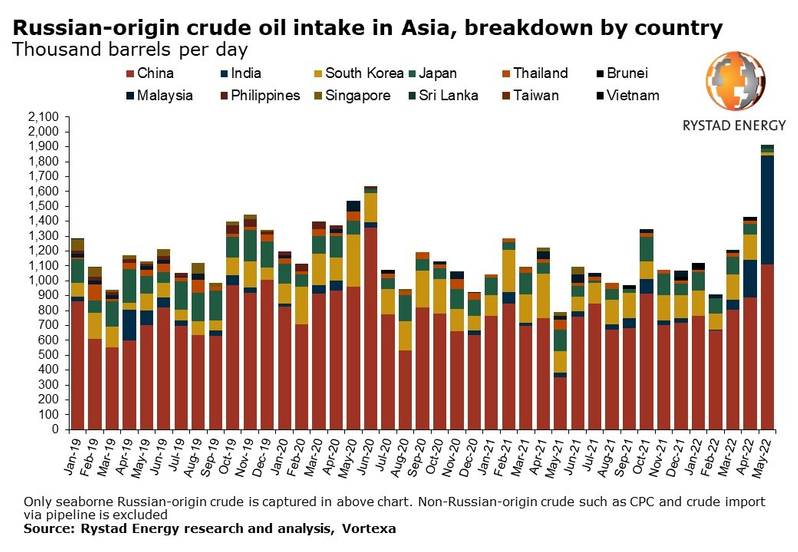Oil Trade; Asia Imports more Seaborne Russian oil than Europe
Almost four months after Russia’s invasion of Ukraine, Russian crude oil, Urals, has seen a switch in flow from its traditional market of Europe to Asia. Since the start of the war, based on the average of March to May 2022, Indian imports of Urals crude have picked up by 658% compared to 2021 levels, while for China the increase is 205% and for Asia as a whole 347%, Rystad Energy research shows.
India has emerged as the significant Urals importer in the region, prompted by the crude’s attractive margin in relation to Middle Eastern grades, which have traditionally been the country’s staple.
With Urals having a similar profile to Middle Eastern oil grades and an advantageous lower sulfur content, Indian refiners have swapped Middle Eastern crudes in favor of Urals for their refinery processing. So long as the Urals discount is maintained, it will have a huge margin advantage over alternative crude grades, meaning Indian refiners are likely to maximize Urals imports.
Since European refiners started shunning Russian oil in late February, Russian crude oil imports to Europe saw a drop of 554,000 barrels per day (bpd) from 2.04 million bpd to 1.49 million bpd between March and May. Russian-origin oil imports by Asian refiners (including China) saw a corresponding 503,000-bpd increase from the January-February 2022 average of 1.14 million bpd to a March-May average of 1.517 million bpd.
The expectation that Russian crude would cease to be traded on international markets has not transpired, and instead the steep discount on Russian crude has seen vessels redirected to alternative markets. While the cost of financing these vessels and trades has increased significantly due to be freezing out of the Western financial system, the discount on Urals is too attractive for some refiners to ignore. As with Iranian oil in the past, once Russian crude is refined, it will become almost impossible to distinguish between those barrels and others as they re-enter the international market.
“Historically, India has taken very little Russian oil but the war in Ukraine and Russian-origin oil embargoes by the Europe Union (EU) have led to a rebalancing in oil trade flows, with Russian-origin crude oil being diverted away from Europe towards India and China instead. Discounts of Russian-origin crude oil have to remain high to provide a compelling refining margin on top of offsetting the high insurance and freight costs associated with purchasing and shipping Russian-origin crude oil.
For now, it is just pure economics that Indian and Chinese refiners are importing more Russian-origin crude oil for processing as such oil is cheap and offers one of the highest crude refining margins compared to other crude grades. Tracking what happens to Russian crude will be a challenge – Europe may end up importing petrol, diesel and other products from India that are blended with Russian Urals,” says Wei Cheong Ho, vice president, downstream at Rystad Energy.


